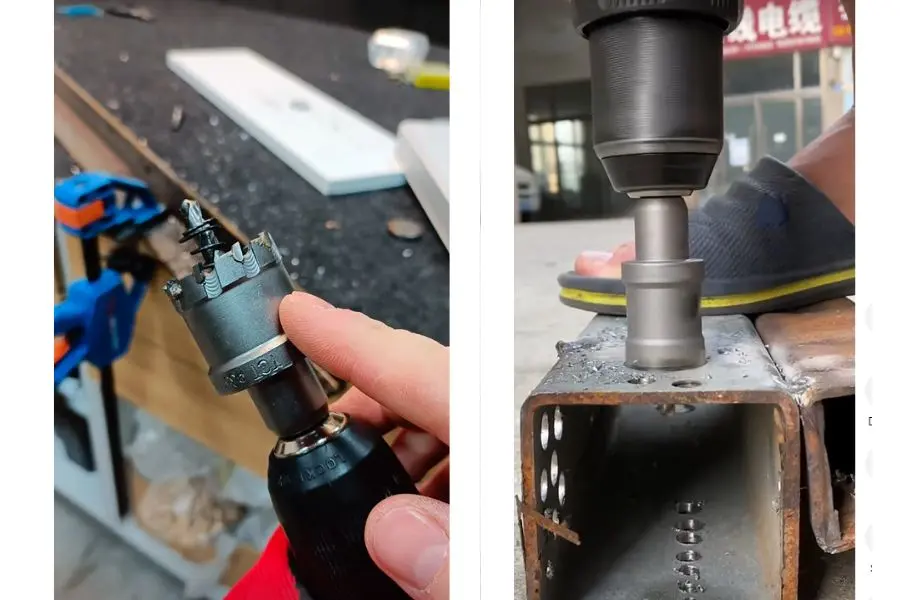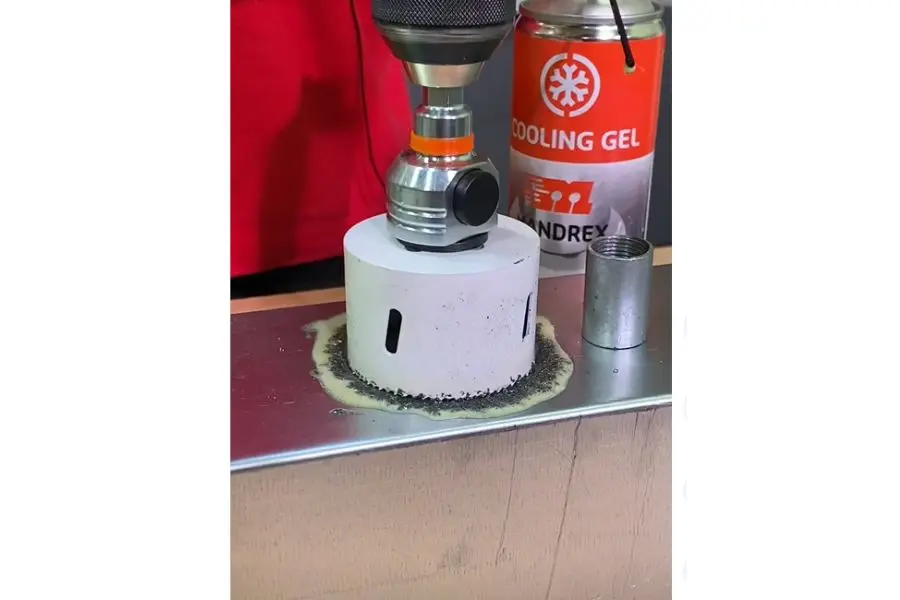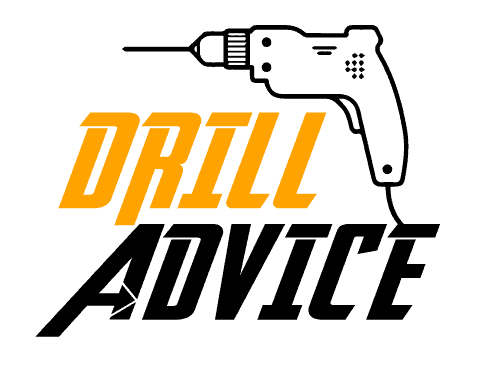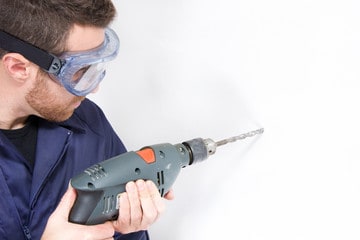Metal hole saw is a widely used drilling tool in metalworking. It is really reliable solution for the sheet metal drilling process. Regular drill bits are good for narrow holes. But for the wider hole, that is not a good solution because wider drill bits are expensive. So the best solution is a metal hole saw.
Metal hole saws are mainly used in 3mm – 10mm sheet metals. Metal hole saws are made with HSS and carbide tips. It has a pilot drill bit to drive the saw inside the metal, and a circular saw is used to cut and remove the metal parts while it is rotating.
When using a metal hole saw, it requires high torque. When it rotates, it tent to interact with a larger surface. Hence it gets hot easily and needs to use coolant continuously.
What Is a Metal Hole Saw?
Metal hole saw is a cutting tool rather than a drill bit. It has a circular saw path. When it rotates, it can cut the path due to the cutting edges (saw teeth). A hole saw has a wider diameter than a drill bit. Hence it can use to drill wider holes that drill bits can’t drill.
Always metal holes are suitable for through holes. When you use a metal hole saw, you should have a pilot hole in order to drive the hole saw into the material.
The saw comprises a circular blade with teeth on its outer edge that is often made of carbide and fits tightly into a hole in a holder or arbor that matches.
An electric drill with the arbor fixed allows the operator to feed material against the spinning blade. Applying lubricants and operating at low speeds increases the lifespan of a hole saw drill bit.
What Is the Cutting Depth of Hole Saw Drill Bits?
It is the entire volume of metal eliminated by the cutting tool during each pass. It is written in millimetres. Depending on the kind of tool and work material, it may change.
The cutting depth of the metal hole saw mathematically equal to half of the diameter difference.
Cutting depth (t) = D-d/2 mm
Metal hole saws have a maximum depth of cut of about 30mm. Although, some of the Bi-metal Hole saws’ cutting depths are 38mm. The 3-inch diameter hole saw has a 1.1-inch (27.94mm) cutting depth.
What Are the Sizes of Metal Hole Saws?
Normally, metal hole saw sizes start from the 16mm, and it can spread over 150mm. When its diameter is wide, its friction force has increased and needs more power to drive the hole saw. So it is not highly recommended to use a wider hole saw every time.
| Diameter /(mm) | Steel | Cast Iron | Non-Ferrous | Plastic |
| 16 | 550 | 365 | 730 | 880 |
| 19 | 460 | 300 | 600 | 740 |
| 22 | 390 | 260 | 520 | 640 |
| 25 | 350 | 235 | 470 | 560 |
| 29 | 300 | 200 | 400 | 480 |
| 32 | 275 | 180 | 360 | 440 |
| 35 | 250 | 165 | 330 | 400 |
| 38 | 230 | 150 | 300 | 370 |
| 41 | 210 | 140 | 280 | 340 |
| 44 | 195 | 130 | 260 | 320 |
| 48 | 180 | 120 | 240 | 290 |
| 51 | 170 | 115 | 230 | 270 |
| 54 | 160 | 105 | 210 | 260 |
| 57 | 150 | 100 | 200 | 250 |
| 60 | 140 | 95 | 190 | 230 |
| 64 | 135 | 90 | 180 | 220 |
| 67 | 130 | 85 | 170 | 210 |
| 70 | 125 | 80 | 160 | 200 |
| 73 | 120 | 80 | 150 | 180 |
| 76 | 115 | 75 | 140 | 170 |
| 83 | 105 | 70 | 140 | 170 |
| 89 | 95 | 65 | 130 | 160 |
| 95 | 90 | 60 | 120 | 150 |
| 102 | 85 | 55 | 110 | 140 |
| 114 | 75 | 50 | 100 | 120 |
| 127 | 65 | 45 | 80 | 110 |
| 140 | 60 | 40 | 75 | 100 |
| 152 | 55 | 35 | 70 | 90 |
What are the Usages of Metal Hole Saws?
These are the uses of the metal hole saws
- Metal hole saws are suitable for drilling through holes.
- Drilling holes to accommodate cable and electrical runs.
- Create cutouts in the ceilings for the placement of downlights, fittings, or lighting fixtures.
- Installing taps and other hardware on worktops, bathtubs, and sinks.
- Installing rails, locks, and other hardware for doors and cabinets.
- Installation of drainage pipes or duct runs through walls and kitchen cabinets.
- General joinery, woodworking, and DIY tasks

What Materials Can Be Drilled Using Metal Hole Saw Drill Bit?
Metal hole saws can be used for various materials, including metals.
Suitable for:
- Metal
- Mild Steel
- Alloy Steel
- Stainless Steel
- Cast Iron
- Brass
- Bronze
- Wood: To prevent splinters, finish the hole from the opposite side.
- Aluminum
- Plastic: Thin plastics can be cut with a hole saw, but if you use a drill in reverse and slow, the plastic won’t melt.
- Iron
- Copper
- Stone
- FRP
* No matter what type of material the holes will be cut in, if it is done quickly, lubricant should be used.

What are the Pros and Cons of Metal Hole Saws?
These are the pros and cons of metal hole saws.
Pros of metal hole saws
- Metal hole saws are high durability and longevity.
- Metal hole saws are excellent for cutting through tough materials.
- Metal hole saws provide precise and clean cuts.
- Metal hole saws are available in various sizes for different tasks.
- Metal hole saws can be used with different types of drills.
- Metal hole saws cause to splintering or breakage.
Cons of metal hole saws
- Metal hole saws are expensive compared to other types of saws.
- Metal hole saws require a steady hand to prevent mistakes.
- Metal hole saws become hot and cause burns if not handled properly.
- Metal hole saws are not suitable for cutting large areas.
- Metal hole saws require additional equipment like a drill press.
- Metal hole saws are difficult to use for beginners.

